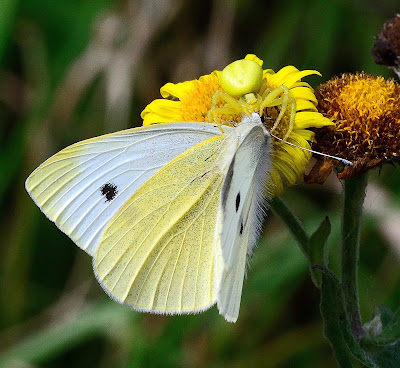Today on a sunny bank along the cliff top at Compton Chine was a Small Copper.She was busily egg laying on a warm afternoon now that the wind of the last few days had abated.Not many butterflies to see however on the landslip apart from a single Large White and a couple of Clouded Yellows.
Thursday 8 October 2015
Monday 7 September 2015
Adonis on Bonchurch Down.
With the prospect of several days of settled sunny weather there was no better time to take a walk on Bonchurch Down to see the Adonis Blue.It seems numbers are less than other years so counts are in tens rather than hundreds. Nevertheless it was a joy to see this most brilliant butterfly on the wing feeding on downland flowers and flying strongly on the Downs' slopes.That is,of course the males as they display those sky blue wings.The females are altogether different with brown wings,although sometimes they show variable amounts of blue.

Friday 4 September 2015
Sky Blue Adonis Blue.
A long overdue visit to Wheelers Bay at Bonchurch yesterday discovered some late summer colour behind the revetment at the base of the cliffs.Several species of butterfly were feeding on the ample drifts of Red Valerian and other flowering plants. Among them, a single male Adonis Blue splendid in striking sky blue. August and September is the time of the Adonis Blue second emergence of the season on our downland,so this individual is some distance away from his usual habitat on Bonchurch Down.
Tuesday 1 September 2015
A Small White and a Small Yellow.
This Small White has fallen prey to a Crab Spider.There is just one species of this spider in the UK apparently belonging the genus Misumena. The spider has the ability to change colour from white,to pale green,and yellow.This allows the spider to match its background, as it sits motionless on a flower bloom awaiting a victim which it pounces on and grasps with its crab-like front legs.

Saturday 22 August 2015
A Magnificent Moth.
Although very common in the UK especially in the south of England,the Oak Eggar is a great sight to see and a magnificent moth.This female was attracted by our house lights.The male which is slightly darker in colour and smaller is generally a daytime flyer and searches for resting females. The female emerges at dusk and flies at night.
Tuesday 18 August 2015
Lesser,But No Less Delightful.
The spectacular beach of Chrissi Ammoudia, or Golden Beach as it is known to tourists on the North Aegean Island of Thassos,Greece is a three kilometre stretch of sand backed by a fertile plain and high hills and mountains.My first visit to this now popular holiday destination was in 1991 when the beach was devoid of loungers and umbrellas and many streams flowed across the reedy and olive grove farmland to the sea.A tourist explosion hit this extensive bay, leading to the development of the new holiday village of Scala Panagia at the northern end of the beach and the building of tourist apartments all along the bay inland of the beach.This was clear on my second visit in 2012,so I was ready for more of the same on this years trip.Thankfully building has not taken place near to the waters edge and therefore the dunes still separate the beach from the holiday apartments.
In these dunes can still be found butterflies and other insects and a good find this time was the small but lovely Lesser Spotted Fritillary.It is not as common as its larger relative,the Spotted Fritillary,but is no less colourful.The sexes are similar in size and colouration as they fly around low to the sand from seed head to seed head.
Thursday 30 July 2015
Something New,Something Blue.
With a report of a probable second brood of Small Blue at a nearby established colony a few days ago,I was at last able to take a look for our smallest butterfly.The weather has been very changeable over recent days but thankfully today the strong wind had abated and we enjoyed some warm sunny periods.It was not long before I came across two mating pairs and although Small Blue colonies tend to be fairly small ,such as this particular one,hopefully a few more butterflies will emerge.
The flight period is from May to late June with an occasional second brood in late July and August.At this location however it is normal for this species to appear in April.
Sunday 26 July 2015
Back to Normal.
The Silver-washed Fritillary is a majestic butterfly of our woodlands in the summer months.The male is a strong flyer along our woodland glades stopping on feed at bramble flowers. The female on the other hand can sometimes be seen flying in the shade of oak trees seeking a suitable place to lay her eggs at the base of the tree.
As they mature the female Silver-washed develop a slight green tinge to their upper wings.This can vary intensity and the female pictured below has a significant greening of her wings.Unlike the valezina form it does not extend to all the upper side.
 |
| Male Silver-washed. |
Saturday 25 July 2015
On the Lookout for Something Special.
In the south of England including the Isle of Wight up to 15% of female Silver-washed Fritillaries occur in the beautiful form of valezina. These females are olive-green in colour with an underside of washed pink.This individual pictured below was spotted today in a nearby copse enjoying the ample bramble flowers.
Thursday 23 July 2015
Pretty as a Picture.
The Painted Lady is a regular visitor to the UK although numbers vary greatly from year to year.We can have several broods during the course of the summer and there cannot be a more pleasant sight than a freshly emerged Painted Lady enjoying the sunshine and feeding in a warm flowery location.Therefore today in my local wood it was lovely to see several individuals on bramble and thistle flowers.
Subscribe to:
Posts (Atom)

















